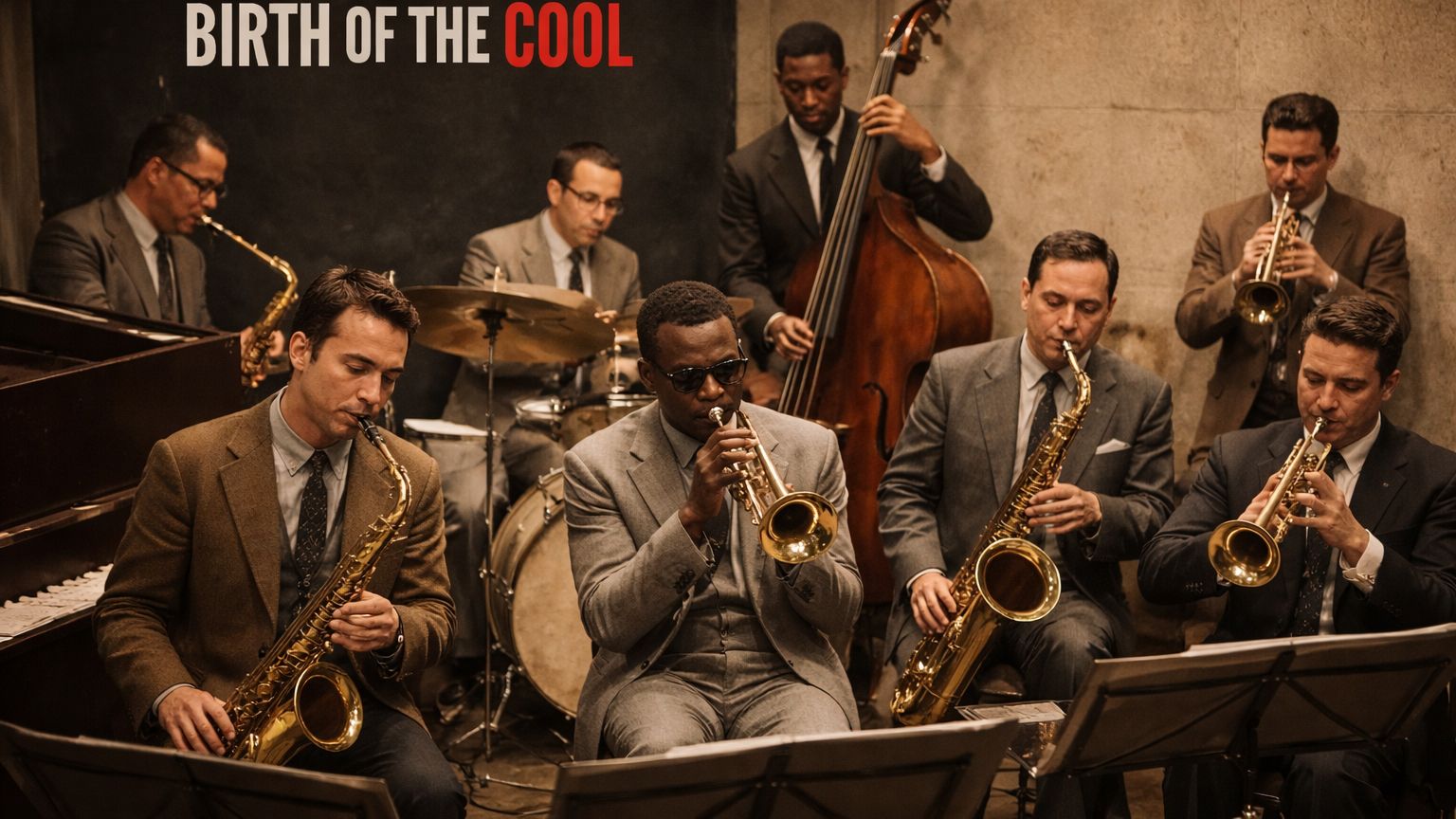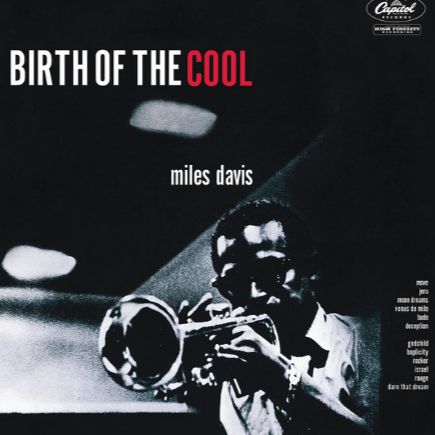Le cool jazz, une modernité tempérée
Une réponse esthétique au bebop
À la fin des années 1940, le cool jazz s’affirme comme une réponse mesurée à la densité rythmique et à la tension expressive du bebop. Sans logique de rupture, il introduit un nouvel équilibre entre sophistication harmonique et lisibilité formelle. Cette orientation traduit une volonté claire de déplacer le centre de gravité du discours jazzistique, en privilégiant la maîtrise du timbre, la continuité mélodique et une pensée formelle étendue. Elle s’inscrit dans une dynamique d’affinement du langage moderne, portée notamment par Miles Davis, Gerry Mulligan et Gil Evans, dans un contexte de profonde redéfinition du jazz d’après-guerre.
Une esthétique sonore maîtrisée
Le cool jazz se distingue par des sonorités feutrées, des dynamiques contrôlées et des tempos majoritairement modérés. Le phrasé, souple et linéaire, favorise la cantabilité et la clarté du discours, au détriment de l’urgence démonstrative. Les attaques sont adoucies, les articulations plus liées, et l’espace sonore devient un paramètre central de l’expression. L’improvisation s’inscrit dans des cadres conçus avec précision, où chaque intervention instrumentale participe à une architecture globale, invitant à une écoute attentive, analytique et durable.
L’héritage européen et la place de l’écriture
L’influence de la musique classique européenne est manifeste, tant dans l’usage du contrepoint que dans l’attention portée aux équilibres orchestraux et à la forme. L’écriture y occupe une place structurante, sans jamais neutraliser l’invention individuelle. Cette hybridation confère au cool jazz une dimension quasi chambriste, où rigueur formelle et liberté expressive coexistent de manière organique, contribuant à légitimer le jazz comme musique de concert.
Birth of the Cool, œuvre fondatrice
Enregistré entre 1949 et 1950 puis publié en 1957, Birth of the Cool constitue une pierre angulaire du jazz moderne. Réuni autour d’un nonette, le projet associe arrangement et improvisation dans un équilibre inédit. La diversité instrumentale, incluant cor, tuba et trombone, enrichit la palette sonore et redéfinit les possibilités formelles du petit ensemble. Cette approche annonce une conception plus collective du jazz, attentive à la forme globale.
Figures et sensibilités du cool jazz
Au-delà de Miles Davis, le courant se décline selon des sensibilités contrastées. Chet Baker et Stan Getz développent un lyrisme introspectif, centré sur la fluidité mélodique et la retenue expressive. Lennie Tristano en explore les implications théoriques et structurelles, tandis que le Modern Jazz Quartet impose un modèle d’équilibre formel et de discipline collective.
Un courant ouvert et durable
Souvent associé à la West Coast, le cool jazz trouve un terrain favorable auprès de musiciens liés à l’orbite de Stan Kenton, tels que Shorty Rogers, Shelly Manne ou Jimmy Giuffre. Toutefois, réduire ce courant à une esthétique régionale serait réducteur. Loin d’être homogène ou figé, le cool jazz demeure un espace d’exploration ouvert, dont l’influence se prolonge durablement dans les pratiques contemporaines.
El cool jazz, una modernidad contenida
Una respuesta estética al bebop
A finales de la década de 1940, el cool jazz se afirma como una respuesta equilibrada a la densidad rítmica y a la tensión expresiva del bebop. Sin una lógica de ruptura, introduce un nuevo equilibrio entre sofisticación armónica y claridad formal. Esta orientación refleja la voluntad de desplazar el centro de gravedad del discurso jazzístico, privilegiando el control del timbre, la continuidad melódica y una concepción formal ampliada. Se inscribe en una dinámica de depuración del lenguaje moderno, impulsada en particular por Miles Davis, Gerry Mulligan y Gil Evans, en un contexto de profunda redefinición del jazz de posguerra.
Una estética sonora controlada
El cool jazz se distingue por sonoridades veladas, dinámicas contenidas y tempos mayoritariamente moderados. El fraseo, flexible y lineal, favorece la cantabilidad y la claridad del discurso, en detrimento de la urgencia demostrativa. Los ataques se suavizan, las articulaciones se vuelven más ligadas y el espacio sonoro se convierte en un parámetro central de la expresión. La improvisación se desarrolla dentro de marcos concebidos con precisión, donde cada intervención instrumental contribuye a una arquitectura global, propicia para una escucha atenta, analítica y duradera.
Herencia europea y función de la escritura
La influencia de la música clásica europea es manifiesta, tanto en el uso del contrapunto como en la atención a los equilibrios orquestales y a la forma. La escritura cumple una función estructurante sin neutralizar la invención individual. Esta hibridación confiere al cool jazz una dimensión casi camerística, donde rigor formal y libertad expresiva coexisten de manera orgánica, legitimando al jazz como música de concierto.
Birth of the Cool, obra fundacional
Grabado entre 1949 y 1950 y publicado en 1957, Birth of the Cool constituye un pilar del jazz moderno. Reunido en torno a un noneto, el proyecto asocia arreglo e improvisación en un equilibrio inédito. La diversidad instrumental, que incluye trompa, tuba y trombón, amplía la paleta sonora y redefine las posibilidades formales del pequeño conjunto. Este enfoque anuncia una concepción más colectiva del jazz, atenta a la forma global.
Figuras y sensibilidades del cool jazz
Más allá de Miles Davis, el movimiento se despliega en sensibilidades contrastadas. Chet Baker y Stan Getz desarrollan un lirismo introspectivo, centrado en la fluidez melódica y la contención expresiva. Lennie Tristano explora sus implicaciones teóricas y estructurales, mientras el Modern Jazz Quartet impone un modelo de equilibrio formal y disciplina colectiva.
Una corriente abierta y perdurable
Frecuentemente asociado a la West Coast, el cool jazz encuentra un terreno favorable entre músicos vinculados a la órbita de Stan Kenton, como Shorty Rogers, Shelly Manne o Jimmy Giuffre. Sin embargo, reducir esta corriente a una estética regional sería limitante. Lejos de ser homogéneo o estático, el cool jazz permanece como un espacio de exploración abierto, cuya influencia se prolonga de forma duradera en las prácticas contemporáneas.
Il cool jazz, una modernità temperata
Una risposta estetica al bebop
Alla fine degli anni Quaranta, il cool jazz si afferma come una risposta misurata alla densità ritmica e alla tensione espressiva del bebop. Senza una logica di rottura, introduce un nuovo equilibrio tra sofisticazione armonica e chiarezza formale. Questa direzione riflette la volontà di spostare il baricentro del discorso jazzistico, privilegiando il controllo del timbro, la continuità melodica e una concezione formale estesa. Si inserisce in un processo di affinamento del linguaggio moderno, sostenuto in particolare da Miles Davis, Gerry Mulligan e Gil Evans, nel contesto della profonda ridefinizione del jazz del dopoguerra.
Un’estetica sonora controllata
Il cool jazz si distingue per timbri ovattati, dinamiche contenute e tempi prevalentemente moderati. Il fraseggio, fluido e lineare, favorisce la cantabilità e la chiarezza del discorso, a scapito dell’urgenza dimostrativa. Gli attacchi sono ammorbiditi, le articolazioni più legate e lo spazio sonoro diventa un parametro centrale dell’espressione. L’improvvisazione si inserisce in strutture progettate con precisione, in cui ogni intervento strumentale contribuisce a un’architettura globale, favorendo un ascolto attento, analitico e duraturo.
Eredità europea e ruolo della scrittura
L’influenza della musica classica europea è evidente, sia nell’uso del contrappunto sia nell’attenzione agli equilibri orchestrali e alla forma. La scrittura assume un ruolo strutturante senza annullare l’invenzione individuale. Questa ibridazione conferisce al cool jazz una dimensione quasi cameristica, in cui rigore formale e libertà espressiva coesistono in modo organico, legittimando il jazz come musica da concerto.
Birth of the Cool, opera fondatrice
Registrato tra il 1949 e il 1950 e pubblicato nel 1957, Birth of the Cool rappresenta una pietra angolare del jazz moderno. Riunito attorno a un nonetto, il progetto combina arrangiamento e improvvisazione in un equilibrio inedito. La varietà strumentale, comprendente corno, tuba e trombone, amplia la tavolozza sonora e ridefinisce le possibilità formali del piccolo ensemble, annunciando una concezione più collettiva del jazz.
Figure e sensibilità del cool jazz
Oltre a Miles Davis, il movimento si articola in sensibilità contrastanti. Chet Baker e Stan Getz sviluppano un lirismo introspettivo, centrato sulla fluidità melodica e sulla misura espressiva. Lennie Tristano ne esplora le implicazioni teoriche e strutturali, mentre il Modern Jazz Quartet impone un modello di equilibrio formale e disciplina collettiva.
Una corrente aperta e duratura
Spesso associato alla West Coast, il cool jazz trova un terreno favorevole anche tra musicisti legati all’orbita di Stan Kenton, come Shorty Rogers, Shelly Manne o Jimmy Giuffre. Tuttavia, ridurre questa corrente a un’estetica regionale sarebbe limitante. Lontano dall’essere omogeneo o statico, il cool jazz resta uno spazio di esplorazione aperto, la cui influenza si prolunga nel tempo nelle pratiche contemporanee.
Cool jazz, a tempered modernity
An aesthetic response to bebop
In the late 1940s, cool jazz emerged as a measured response to the rhythmic density and expressive tension of bebop. Without embracing rupture, it introduced a new balance between harmonic sophistication and formal clarity. This orientation reflects a clear intention to shift the center of gravity of jazz discourse, privileging timbral control, melodic continuity, and extended formal thinking. It forms part of a broader refinement of modern jazz language, notably shaped by Miles Davis, Gerry Mulligan, and Gil Evans, within the context of the postwar redefinition of jazz.
A controlled sonic aesthetic
Cool jazz is characterized by muted sonorities, restrained dynamics, and predominantly moderate tempos. Phrasing is smooth and linear, favoring lyricism and clarity over demonstrative urgency. Attacks are softened, articulations become more connected, and sonic space emerges as a central expressive parameter. Improvisation unfolds within carefully designed frameworks, in which each instrumental contribution participates in a global architecture, encouraging attentive, analytical, and sustained listening.
European heritage and the role of composition
The influence of European classical music is evident, both in the use of counterpoint and in the attention paid to orchestral balance and form. Composition plays a structuring role without neutralizing individual invention. This hybridization gives cool jazz a near-chamber dimension, in which formal rigor and expressive freedom coexist organically, reinforcing jazz’s legitimacy as concert music capable of engaging with other learned traditions.
Birth of the Cool, a foundational work
Recorded between 1949 and 1950 and released in 1957, Birth of the Cool stands as a cornerstone of modern jazz. Organized around a nonet, the project combines arrangement and improvisation in an unprecedented balance. The instrumental diversity, including French horn, tuba, and trombone, enriches the sonic palette and redefines the formal possibilities of the small ensemble, announcing a more collective conception of jazz attentive to overall form.
Figures and sensibilities of cool jazz
Beyond Miles Davis, the movement unfolds through contrasting sensibilities. Chet Baker and Stan Getz cultivate an introspective lyricism centered on melodic fluidity and expressive restraint. Lennie Tristano explores its theoretical and structural implications, while the Modern Jazz Quartet establishes a model of formal balance and collective discipline.
An open and enduring current
Often associated with the West Coast, cool jazz also found fertile ground among musicians linked to the orbit of Stan Kenton, such as Shorty Rogers, Shelly Manne, or Jimmy Giuffre. However, reducing the movement to a regional aesthetic would be misleading. Far from being homogeneous or static, cool jazz remains an open field of exploration, whose influence continues to resonate durably in contemporary practices.

generated by ChatGPT (AI)


